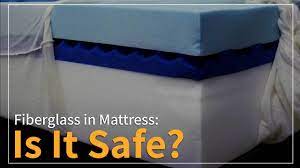Fiberglass in your Nectar mattress?

Fiberglass In Your Mattress?
… Could Be! And It’s Potentially Dangerous
Here at Asbestos Abatement, Inc., we’re often amazed at the dangerous stuff that ends up on the market because it’s cheaper to make than stuff that’s safe.
Way back in The Old Days, when people would light up a cigarette while watching their late-night TV shows in bed, disasters happened when those same people fell asleep and let their lighted cigarette start a bad house fire – beginning with the very mattress they were sleeping on.
This prompted The Government to create legislation requiring that mattresses have a flame-retardant barrier included in them. And this legislation is certainly well-intended.
So guess what manufacturers were using as the “flame-retardant barrier” in their mattresses? That’s right, our ugly old friend, asbestos.
Asbestos IS fire-resistant, since it’s basically a rock. But if a mattress (or just about any other asbestos-containing material) catches fire, the asbestos breaks down into nasty, microscopic shards which can embed themselves in your lungs and cause a type of lung cancer for which there’s no cure.
Nevertheless, from about the 1920s until the late 1970s, many asbestos-laden mattresses found their way into American homes.
When the dangers of asbestos were fully explored, The Government banned it. But shortly thereafter, the federal courts overturned the ban. So while it’s still illegal to manufacture asbestos-containing products in the U.S., it’s not illegal to import them from other countries, and tons of the stuff come ashore each year.
Your walls, floors, pipe insulation, and even some faux jewelry contain asbestos!
But not your mattress.
There was still a requirement to include a fire barrier in a mattress, but that barrier can no longer be asbestos. So certain manufacturers tried chemical fire barriers… and those, too, have now been banned because they’re toxic.
Ever enterprising, manufacturers of inexpensive mattresses have found a new type of fire barrier: Fiberglass. It’s often marketed as “glass fibers” or “glass wool,” but basically, it’s fiberglass you’ll find in many cheaper mattresses (particularly, many mattresses that come as a “bed in a box”).
If you buy a mattress in a box, and the warning label says you shouldn’t remove the mattress cover, chances are, there’s fiberglass in there.
Now, fiberglass ain’t asbestos… but it presents its own dangers. For instance, most people sleep on their mattresses, and even move around on them. This can cause the fiberglass to do the same thing asbestos would do: break down into microscopic fibers, and “leak” out into the air in your home.
Whether it’s microscopic shards of rock, or microscopic shards of glass… either way, microscopic shards are not a good thing to be breathing. In fact, prolonged and intense exposure can permanently damage your lungs, and eventually, it can kill you.
So have your home professionally tested for asbestos, sure… and if there’s a problem, we can solve it for much less than you might think.
But while you’re at it, or even if you’re not at it, take a look at the “ingredients” in your mattress – especially if it was uber-affordable. If the thing contains “glass fibers” or “glass wool,” give strong consideration to replacing it with a better, safer mattress.
If you haven’t been sleeping on fiberglass too long, you’re probably still okay. But don’t wait until that’s not the case!
Our customers sleep easy at night, because they know their home is asbestos-free. But if you’re sleeping on a fiberglass-containing mattress – not to overstate the worry – it might be hard for you to get a good night’s sleep now that you’re aware of the dangers. Check your mattress!
